Archway represents a kind of traditional Chinese culture showed in architectures. It is usually built by the permission of the emperor to commend meritorious deeds in feudal China. In Huizhou area of Southern Anhui Province, archways, Hui-style houses, and ancestral temples are called the "three masterpieces" of ancient Chinese architecture. Building an archway is one of the highest pursuits of the ancient people. It brings great honor to the man himself and his whole family, and his name will perpetually be remembered by posterity.
Tangyue memorial archways are at the entrance of Tangyue Village. They are all axisymmetric with delicate carvings, giving people a sense of solemnness. There are farmlands on both sides along the road and no other buildings around. Looking at the archways from a distance, they are particularly prominent and seem like rising straight from the ground. The archway group and the farmland, trees, ponds, rivers and ancient bridges constitute a complete external environment of the village, reflecting the site selection and village construction principles of ancient people, which is it should be in accordance with local conditions and ensure harmonious coexistence between man and nature.
Tangyue memorial archways represent the architectural art in the Ming (A.D. 1368-1644) and Qing (A.D. 1644-1911) Dynasties. Although the 7 archways are built at different time (3 in the Ming Dynasty, 4 in the Qing Dynasty), they look like an integral whole. Different from the traditional wooden archways, Tangyue memorial archways are mainly made of a kind of high-quality stone called "Shexian Qing". The archways are solid and tall. Neither nails nor rivets are needed in the construction. The skillful craft ensures that the archways can stand straight even after thousands of years.
Huizhou in ancient China is a place with large population but little land. Therefore, they could not make a living on farming. Huizhou men had to leave their home to learn and do business at about 13 to support their family. It was really hard because there were too much to learn and too many uncertainties in doing business. They were always on the go and seldom came back home. Huizhou people were deeply affected by Confusian ideas (taking "benevolence" as its core) and attached much importance to the upbringing of morality. The archway group tells 7 heart-touching stories crossing 400 years, but it is just a epitome of Tangyue people.
Whether you see them from the front or from the rear, the seven tall and magnificent archways are arranged in the order of "loyalty, filial piety, moral integrity and righteousness", which shows the virtues of Tangyue people.
Bao Can Filial Piety Archway was built in the early Jiajing period(A.D. 1522-1566). It is 9.54 meters wide and 8.86 meters high. Under the cornice, the archway is inscribed with the word "圣旨"(imperial edict). And there is a pair of relief male lions on each side of the crossbeam. Bao Can is quite knowledgeable, but he has no desire in getting an official rank. His mother has long been suffering from deep-rooted ulcer on her feet. Bao Can tended his mother dedicatedly and even sucked the pus of her mother's feet out until she was healed. The villages were moved by his filial piety and built this archway after getting the permission of the emperor.
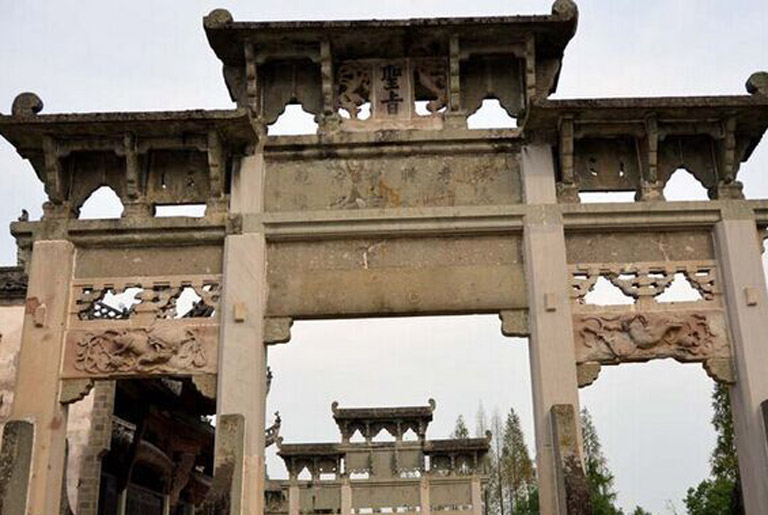 Bao Can Filial Piety Archway
Bao Can Filial Piety Archway
Cixiao Archway, built in A.D. 1420, is 8.57 meters wide and 9.6 meters high. It is engraved with "御制" (made by the emperor’s order) and "慈孝里" (kindness and filial piety), which means that it is built by the order of the emperor with the money from the National Treasury. It is built for the father and son Bao Yuyan and Bao Shouxun. They were once caught by a rebel army and one of them had to be killed. The army leader asked them to make the decision and expected that they would fight over this. However, they are both willing to die to let the other survive. The love of the father and the filial piety of the son even moved the man who wanted to kill them. Later, the royal court heard about their story and granted the building of the archway. It was carved with a poem written by Emperor Yongle(A.D. 1360-1424) for them. During Hongzhi period (A.D. 1488-1505) in the Ming Dynasty, Qianlong period (A.D. 1736-1795), Tongzhi period (A.D. 1862-1874) and Guangxu period (A.D. 1875-1908) in the Qing Dynasty, it was renovated for several times. It is of the highest level among the 7 archways.
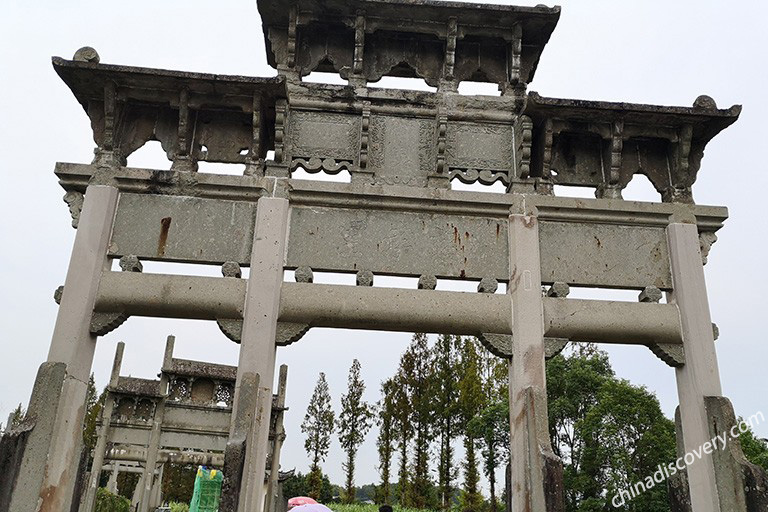 Cixiao Archway
Cixiao Archway
Bao Wenling’s Wife Wang’s Chastity Archway was built in A.D. 1784. Wang’s husband died when she was 26. She chose not to marry again and cultivated her son into a famous doctor in Shexian County. In the patriarchal society, preserving chastity and nurturing their descendants are regarded as the greatest filial piety for a widow. Imagine what kind of love and perseverance will a woman need to help her get through the countless days and nights after her beloved one left. So when Wang was 80 years old, her clansmen asked permission to build this memorial archway for her. It stands firmly since then just like the persistent Wang herself.
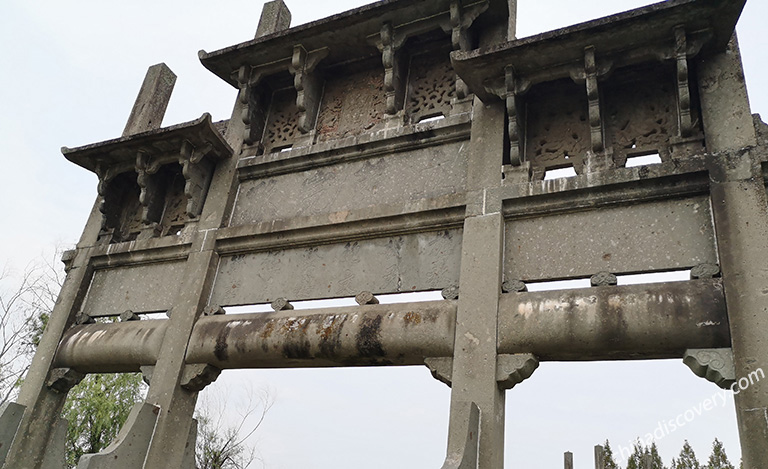 Bao Wenling’s Wife Wang’s Chastity Archway
Bao Wenling’s Wife Wang’s Chastity Archway
Bao Shufang Father & Son Archway, built in A.D. 1820, is 11.82 meters wide and 11.70 meters high. The archway was built to honor Bao Shufang and his son Bao Jun. Bao Shufang was a successful and kind-hearted salt merchant. He gathered other merchants to donate 60,000 dan (about 6 million liter) rice to the disaster-stricken areas when Hongze Lake burst its dike, and 40,000 dan wheat when Huaihe River and Yellow River areas suffered from floods. After that, he raised 3 million silver kuping taels (worth about $75 million US Dollars in 2015) to improve local water conservancy project. Apart from that, he spent a lot of money setting up ancestral temples and schools, repairing bridges and roads in his hometown. He also helped many poor people. When he was on his deathbed, he still told his son Bao Jun to try his best to benefit his hometown and help others. The governor of Huizhou Prefecture was moved by the many righteous actions of Bao Shufang and Bao Jun. Therefore, he asked for permission to build the archway to cite their kindness and generosity.
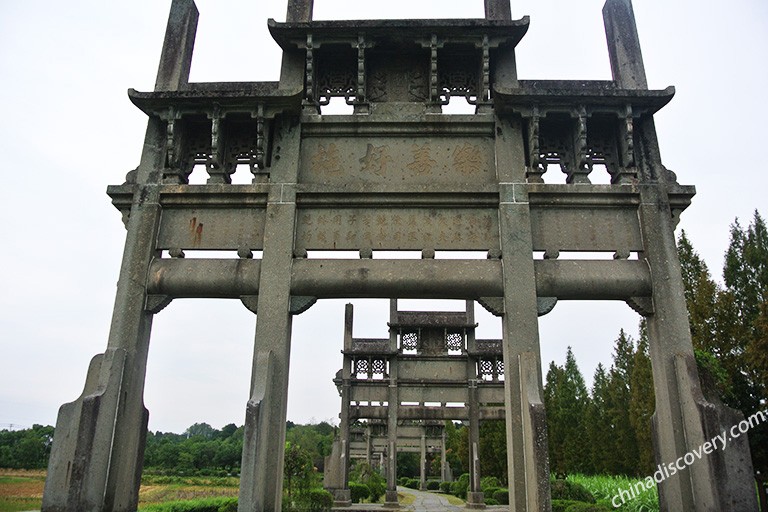 Bao Shufang Father & Son Archway
Bao Shufang Father & Son Archway
Bao Wenyuan’s Wife Wu’s Chastity Archway was built in A.D. 1768. Wu married Bao Wenyuan when she was 22 years old and widowed at the age of 29. She decided not to marry again and took care of the child of Bao Wenyuan and his ex-wife, Bao Yuanbiao, and served her mother-in-law to the end of her life. Bao Yuanbiao also didn’t fail his mother and became a famous calligrapher. After Wu entered her senior years, she spent all her money building an ancestral tomb for her deceased husband and other family members who were not decently buried. This showed the filial piety for ancestors, and of course, it was praiseworthy. Wu died at the age of 60. What she did moved local officials, so they broke the rule that a step wife was not allowed to set up a memorial archway. They made an exception for her in building a memorial archway of the same size as others.
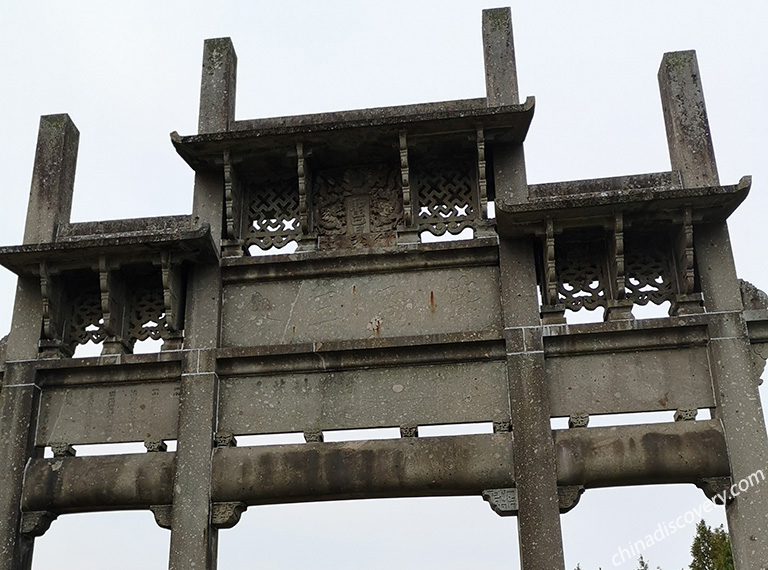 Bao Wenyuan’s Wife Wu’s Chastity Archway
Bao Wenyuan’s Wife Wu’s Chastity Archway
Bao Fengchang Filial Piety Archway, built in A.D. 1797, is engraved with Chinese words “人钦真孝”(people admire his true filial piety). The archway was built for the dutiful son Bao Fengchang. In the turbulence of the late Ming Dynasty, Fengchang's father went out to make a living but had never been heard of since. In A.D. 1646, Fengchang, who was only 14 years old, begged along the way for thousands of miles to look for his father. Finally, he found his sick father at Yanmen Temple in Gansu Province. He tended his father with all his heart until his father cured. But as they got home together, Bao Fengchang found that his mother was sick abed. So he spared no efforts to get the medicine his mother needed from Zhengjiang Province. His mother made a miraculous recovery after taking the medicine. The clansmen all said it was his filial piety that healed his mother.
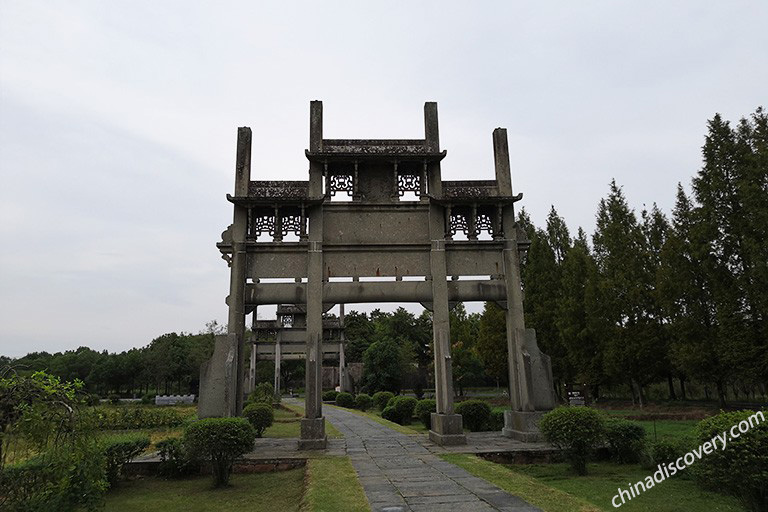 Bao Fengchang Filial Piety Archway
Bao Fengchang Filial Piety Archway
Bao Xiangxian Archway, built in A.D. 1622, was to commend the great contributions Bao Xiangxian had made to guarding Yunnan and Shandong provinces. According to Shexian County annals: Bao Xiangxian, the great-grandson of Bao Can passed the three-tiered imperial examinations from local to provincial to court exams and became Jinshi (a title granted to the advanced scholars) in A.D. 1529. At first, he was appointed as censor, and then assistant minister of the Ministry of War. As he appeased the border turmoil in Yunnan Province, local people built a memorial temple for him when he was still alive to show their gratitude. Bao Xiangxian was righteous and would not fawn on the bigwigs, so he has been slandered by treacherous officials for many times, and his political career has suffered several ups and downs. However, he had always remained true to himself and loyal to the country. He was conferred a posthumous title as minister of the Ministry of Works and the archway was built after he passed away.
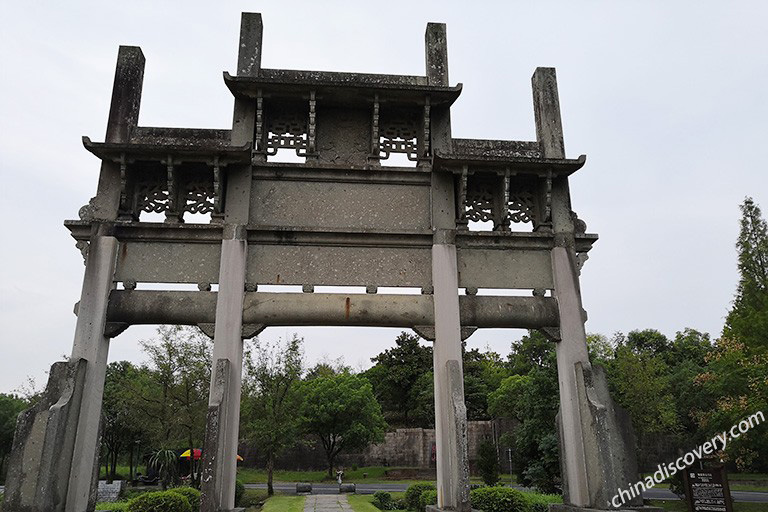 Bao Xiangxian Archway
Bao Xiangxian Archway
Qingyi Hall was built by the great salt merchant Bao Qiyun in the early years of Jiaqing period (A.D. 1796-1820). Qingyi in Chinese means "purity, chastity, virtue and beauty". Qingyi Hall was built only for women and used exclusively by women, commemorating women in Bao family (almost all Tangyue people were surnamed “Bao”) who also made sacrifices and contributions to the success of Huizhou merchants. This is unprecedented in China's history. Because in feudal China, men enjoyed higher status than women. In some places, women were even not allowed to enter an ancestral hall. However, in Tangyue, women could not only enter the ancestral hall, but also worship and discuss women matters here. Qingyi Hall, the only ancestral hall for women in China, is an eternal ode to women.
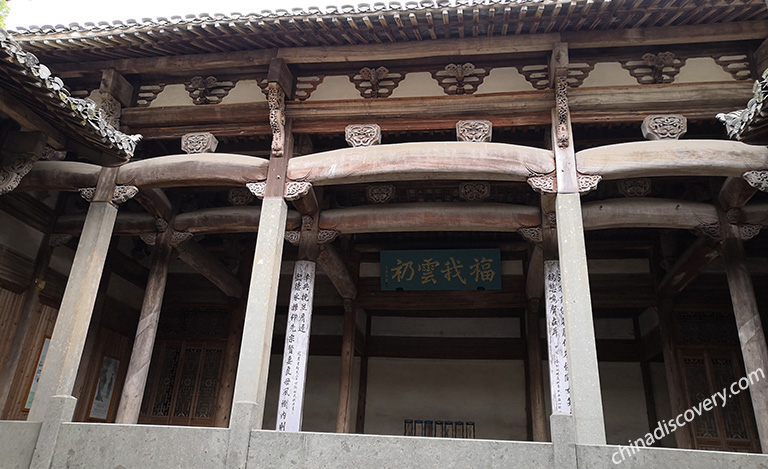 Qingyi Hall
Qingyi Hall
Tangyue Memorial Archways lie about 25km to the north of Huangshan City. There are no flights or trains to get there, therefore, you need to get to Huangshan City first and then transfer to Tangyue. You can buy bus tickets and check the latest timetable (not fixed) at Huangshan Bus Station (Tunxi). But usually there are no direct buses. You need to take a bus to Shexian County first, which is kind of inconvenient and time-consuming.
Or you can travel with us to save all the troubles. We will provide you with cosy vehicles, professional guides and drivers. It will only take 40 minutes to drive to Bao Family's Garden from Huangshan City. What’s more, all the pick-up and drop-off services in the trip are included. It is very convenient if you want to travel somewhere nearby. For more details, please feel free to contact us.
Tangyue Memorial Archways are open to visitors all year round. Its annual average temperature is about 16°C. The hottest day can reach 40°C in August and the coldest (-6°C) is usually in January. Therefore, the best time to go is in the mild spring from March to May, especially in April when you can enjoy the vast rape flowers in the fields, and the cool autumn from September to November.
A half day is usually sufficient to well explore Tangyue Memorial Archways and Bao Family’s Garden, which is only 10 minutes’ walk away.
If you want to enrich your trip, here are some attractions nearby you can choose. Huizhou Ancient City, about 10km to the east of the garden, is a well-preserved ancient city built 2200 years ago. Or you can drive west for about 10 minutes to get to Tangmo Ancient Village. Here you can see the best Shuikou Garden in China. Then keep driving west for another 10 minutes to Qiankou Ancient Residential Houses. It is a traditional Hui-style architecture complex built in the Ming Dynasty(1368-1644). After that, drive northwards for about 15 minutes, then you will get to Chengkan Ancient Village, a village built totally according to Feng Shui theory with the best-preserved architectures in the Ming Dynasty. A package ticket for all the scenic spots is CNY 220 yuan per person, which will save you about 200 yuan compared to buying the tickets separately. The package ticket is valid for two days.
If you want to travel somewhere farther, the famous UNESCO World Heritage Site Huangshan Mountain(1.5 hours' drive) and the picturesque Hongcun Ancient Village(about 2 hours' drive) are also ideal options.
If you do not know how to schedule your trip, here is a classic 4 Days Huangshan to Huizhou Culture Exploration tour that covers most of the attractions mentioned above for your reference. We are specialized in customized trips. If you are not satisfied with the plan, please send us your needs and requirements and we will offer you a personal tailor-made trip!
Top 3 Huangshan tours chosen by most customers to explore Huangshan in the best way. Check the detailed itinerary, or tailor your own trip now with us.
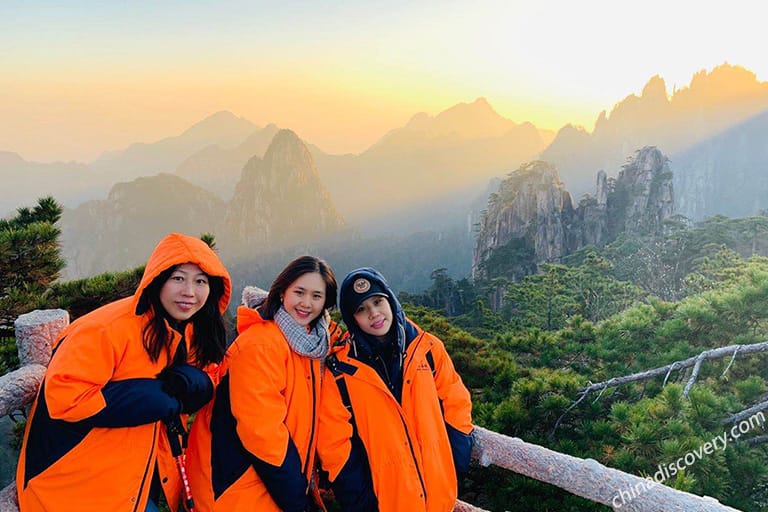
Tunxi - Huangshan - Tunxi
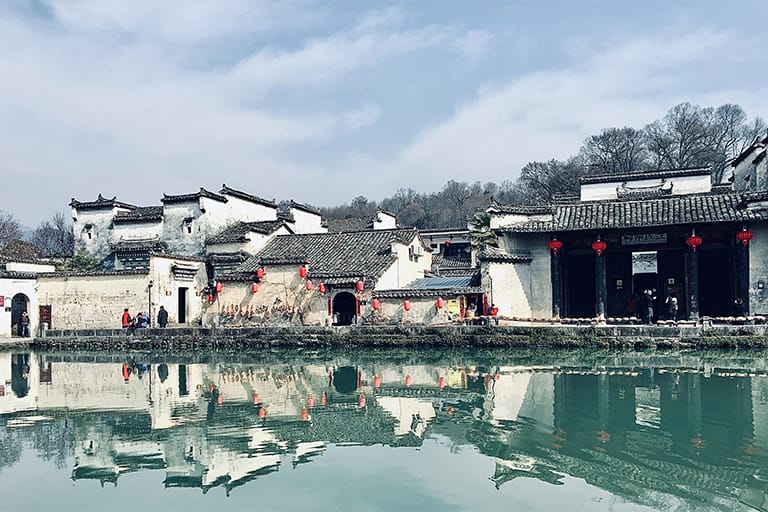
Tunxi - Huangshan Mountain - Hongcun - Xidi
Start planning your tailor-made holiday to China by contacting one of our specialists. Once inquired, you’ll get a response within 0.5~23.5 hours.
Customize a Trip